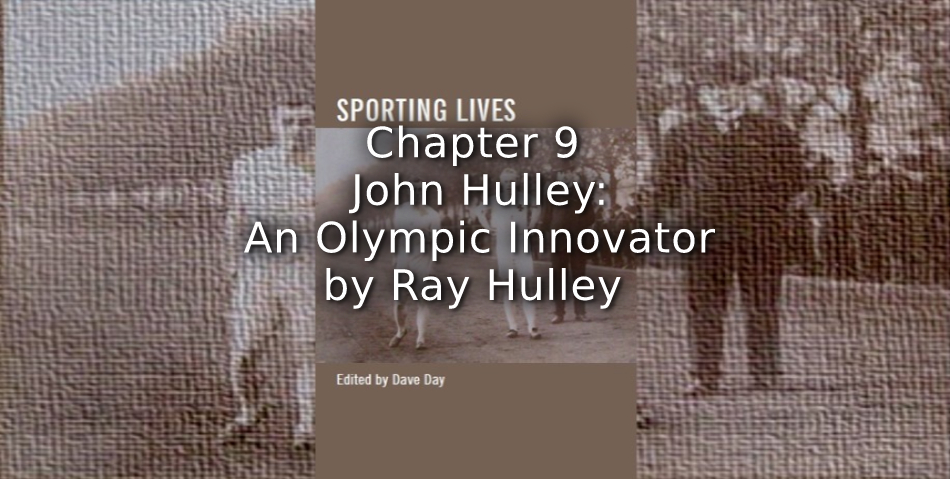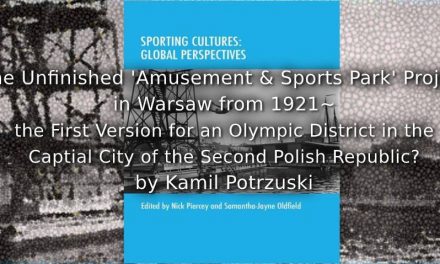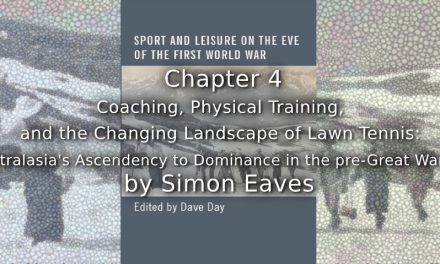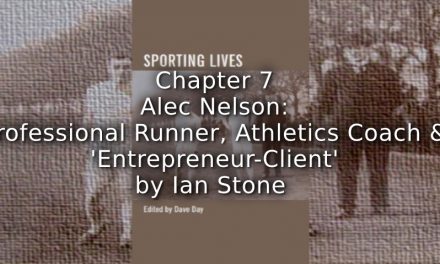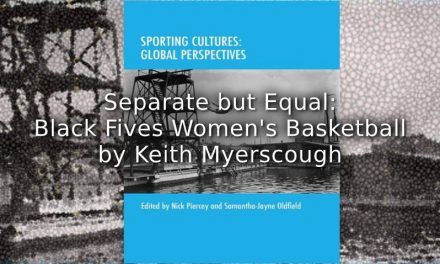Playing Past is delighted to be publishing on Open Access – Sporting Lives, [ISBN 978-1-905476-62-6] a collection of papers on the lives of men and women connected with the sporting world. This edited volume has its origins in a Sporting Lives symposium hosted by Manchester Metropolitan University’s Institute for Performance Research in December 2010.
Please cite this article as:
Hulley, R. John Hulley – An Olympic Innovator, In Day, D. (ed), Sporting Lives (Manchester: MMU Sport and Leisure History, 2010), 126-141.
9
______________________________________________________________
John Hulley – An Olympic Innovator
Ray Hulley
______________________________________________________________
Many of us will have enjoyed watching the events of the Beijing Olympics in 2008 and look forward to the London Olympic Games in 2012. I will be particularly keen because I have discovered my own Olympic hero during my family history researches in the past 4 years. I am a member of the Guild of One-Name Studies, the Manchester and Lancashire Family History Society and the North Cheshire Family History Society and have been researching my surname since 1980. In November 2006 I came across an article about a John Hulley of Liverpool in the Winter 2001 edition of the Journal of Olympic History. The title included a representation of the 5 Olympic rings and the mystery was because he had been the forgotten man of British Olympic history and all trace of him after 1868 had been lost. Never shirking a challenge of this nature, I decided to follow up this lead to try to solve the mystery. I discovered that Hulley had been born in Liverpool in 1832 and was a descendant of a Hulley family from Frodsham and previously Macclesfield. I have researched this family back to 1488 so he is well founded. His father, 2 uncles, a grandfather and great grandfather had been surgeons or physicians and another uncle had been a chemist and druggist. The Family Tree below shows four generations of ancestors of John Hulley.

My next step was to find out more about John and his family in Liverpool and I discovered him in 1841 living at Gloucester Street Liverpool with his mother.[1] He had had a keen interest in physical activities, education and fitness and it was reported that in his early years he had been taught by Louis Huguenin, the famous French gymnast who had settled in Liverpool in 1844 as a teacher of Gymnastics. John attended Huguenin’s school in a court at the top of Lord Street for several years before matriculating from the Collegiate Institute, Shaw Street, Liverpool in 1850.[2] In 1851 John was a visitor to his Uncle Hugh Speed’s Brookhouse Farm at Huyton where no doubt he enjoyed the fresh air and farmyard activities.[3] John Hulley was again living at a farm in Huyton in 1861, but this time he was a visitor to his uncle Edward Speed at Woolfall Hall where there were 90 acres of farmland.[4]
The Role of Physical Education
John Hulley’s first public presentation was given on 25 April 1861 at the Theatre Royal Liverpool, and was part of a display by members of the 79th Lancashire Volunteer Rifles, (composed predominantly of the middle class) entitled “A Grand Assault of Arms.” By the kindness of Colonel M. Martyn, of the 2nd Life Guards, several of the picked swordsmen of that regiment were permitted to take part in the contests.
John Hulley who was a member of the 79th, opened the proceedings by delivering an address on “Physical Education” in which he said –
There is scarcely one of us whose physical state is what it ought to be. Poor, weak, pale, dyspeptic beings we are, unworthy of the name of a man, whatever learning or mental attainments we may possess. We may dazzle our fellow men by these one-sided accomplishments, we may win their short-sighted praise, but we shall not cheat nature, nor reap ought but her punishment to us and our children. When our day of physical affliction comes, as come it certainly will, to everyone who neglects his body, when the retribution head is laid heavily on ourselves and on our children, then shall we feel the vanity and delusiveness of our preference for one set of our faculties above the other.
A man who cultivates his personal appearance and takes a pride in his handsome and athletic figure is called a coxcomb, while the puny delicate man of letters, who exalts in his mental superiority, and who boasts of the triumph of mind over matter, is thought to have a noble and excusable pride. The attention and reverence for physical beauty is one of the best safeguards for health and manly vigour. Beauty of face and figure is only to be maintained and perpetuated to coming generations by exercise of our body powers and is one of the best signs of a well-spent life. In truth the great want of physical beauty and manly strength and elegance of frame, which is so widespread among us, is as distressing and as deeply to be deplored, as the prevalence of moral evil, of which, in fact, it is the outward and visible type. No qualities of mind can make up for this sinful and miserable neglect of the body. The moral virtues themselves are to be promoted at present through the physical ones, for in the present state of physical degradation, in which we live, it is a vanity to imagine that high moral excellence can prevail. Therefore the earnest culture of the bodily powers by every one of us is the surest means to elevate mankind.
We should not be contented with a low standard of physical elevation. We should make it our religious aim, that every one of us, man, woman, and child, should possess a large, powerful frame, whose blooming health shall set consumption and other diseases of debility, at deliverance. Each man and woman should take as much pride, in the cultivation of the bodily as of the mental faculties, feeling deeply that the grand truth, that the interests of our race are just as much bound up in the right development of the ones as of the other. We should not be content until the thews and sinews, the powerful bodied and manly minds of our ancestors become prevalent among us and are blended with the advantage of our advanced civilisation, with our greater enlightment and refinement, and a longer average of life, we should cultivate all those sports and manly exercises which promote bodily health and vigour, just as sedulously as we cultivate any other branch of education, for no amount of mental cultivation, intellect, or wealth will ever make up to a community for the lack of manly mode ability and pluck.
History is full of examples of intellectually developed nations, but intellectual only, falling a prey to others of inferior mental calibre, but of daring and overwhelming physique. Therefore we should have an equal honour to physical as to mental excellence. Whenever we see it, we should learn to take an equal pleasure in it, and to have an equal reverence for the physical and the mental sciences and to attain to a well valued grandeur a like of the material and of the moral universe.[5]
Another “Assault at Arms” organised by John Hulley was again held at the Theatre Royal on 5 December 1861, with Hulley repeating the address given at the same place in April.[6]
The First Liverpool Olympic Festival
In June 1862 John Hulley initiated the first Grand Olympic Festival at the Mount Vernon Parade Ground in Liverpool, which was a forerunner of several of these competitions with a physical prowess flavour. In the advertisement for the Festival it was stated that no effort would be spared by the Committee not only to render the Festival worthy of its immortal title, but also to make it the means of drawing more public attention to the important subject of physical education.[7]
Gold, silver and bronze medals were awarded in these 3 competitions: 1100 yards Steeplechase; 1½ mile Race; 4 mile Walking Race.
Silver and bronze medals were awarded in the following competitions: Fencing; Vaulting; ½-mile Race for LAC members; Broadsword; Boxing; Throwing the Disc; Sabre v. Bayonet; 120 yards Race; Throwing the Cricket Ball; Jumping; 300 yards Race; Indian Club Exercises; Leaping; ½-mile Race for Youths; Dumb-bell Exercises.
A gold medal or ten guineas was also awarded for the best essay on Physical Education.

Figure 1
Charles Pierre Melly
The Festival was a success and Mr Melly, President of the Liverpool Athletic Club said that before they left the ground he thought it was his duty to tell them through whose exertions that delightful afternoon’s amusement had been afforded to them. They were indebted for it to Mr John Hulley, the excellent honorary secretary of the club, and it was entirely owing to his indefatigable and praiseworthy exertions that the festival had been brought to such a successful and highly satisfactory issue. Mr Melly then called for three cheers for Mr Hulley, which were given right heartedly, with “one cheer more.” The report ended with wholesome praise for John Hulley. “It is due to Mr. Hulley that the whole direction and management of the festival devolved upon him. He was unremitting in his exertions throughout the day, and there is no doubt that to his courtesy and zeal that the successful issue of the undertaking was mainly attributable.[8]
Establishment of the Rotunda Gymnasium, Bold Street Liverpool
Later in 1862 the Rotunda Gymnasium was established in Bold Street, Liverpool by a partnership between John Hulley who looked after the Gymnasium side of the business, and Samuel W. Ackerley, who raised the capital for a mortgage deposit on the premises. It was clearly understood between them that Hulley’s practical experience was to be considered as of equal value with his capital. Ackerley was to look out for premises and both took steps to secure the Rotunda in joint names. The actual purchase, however, was made in Mr. Ackerley’s sole name, but with a clear understanding that if in future the property was sold the profit should be equally divided between them. The President of the Gymnasium was Charles Pierre Melly, great grandfather of the late George Melly, musician and entertainer, and Andre Melly, film actress. Charles Melly was a Liverpool philanthropist born in 1829. He was famous for providing 43 public drinking fountains around Liverpool in the mid-19th c, as well as being instrumental in the founding of the Gymnasium.
The reputation of John Hulley in the sphere of physical education increased dramatically over the next year or so. The good example set by him at Liverpool was replicated at Manchester, where newly established Athletic Club held an Assault-at-Arms in the Free Trade Hall. Several of the pioneers of the physical education movement had been invited to attend and take part in the proceedings, including John Hulley. A correspondent to the Liverpool Mercury reflected the mood of the time regarding physical education in Liverpool, writing,
“Gentlemen, I think there could not be a better time than the present, now that such a deal is being made, said and written on the important subject of physical education, to express my opinion with regard to a testimonial being presented to Mr John Hulley, honorary secretary of the Athletic Club. I think no one man in Liverpool has done more for his fellow-townsmen than Mr Hulley. He, in a great measure, may be called the pioneer of the great movement in this town.[9]
Even the landed gentry were aware of the undoubted progress made with physical education and the leading part played in its promotion by John Hulley. Sir Edmund Lachmere, 2nd Baronet of Hanley Castle, and High Sheriff of Worcestershire wrote to him requesting a copy of the rules and other particulars of the Liverpool Athletic Club. Sir Edmund was very desirous to encourage athletic sports and a competition for prizes in the pleasure grounds at Worcester, and he wished to procure all the information he can as to the establishment of athletic games in other places.
The second annual great Olympic Festival (now entitled ‘International’) in connection with the Liverpool Athletic Club took place at the Mount Vernon Parade Ground Liverpool on Mr. Hulley, the indefatigable honorary secretary, and the committee, had used every excursion to render the affair a complete success, and the thousands who were present on Saturday, must admit that this second Olympic Festival was highly successful in every respect.[10]
The public pressure for the importance and advantages of physical education reached the edges of the Lake District with the small town of Ulverston inviting John Hulley and 12 of his Liverpool Athletic Society colleagues to the town in October 1863. Gymnastic illustrations were a novelty in Ulverston, and the meeting attracted one of the largest and most intelligent audiences ever assembled within the Concert-hall. John Hulley was warmly welcomed by the audience who listened attentively to what he had to say about his favourite topic – Physical Education.[11]
Another Grand Assault-at-Arms was held at a crowded Theatre-Royal in December 1863 by members of the Liverpool Athletic Society and organised by John Hulley. But the year closed with a shock announcement by Samuel Ackerley, the co-partner of Hulley in the Bold Street Gymnasium that Hulley will cease to have any share in the Direction of the Establishment from 31 December 1863. This came as a complete surprise to John Hulley, who explained his side of the case very clearly and in great detail in the local newspapers. Ackerley had reneged on an agreement and simply dissolved the partnership.[12][13]
Establishment of the New Liverpool Gymnasium
This setback was only a temporary one for within 3 months a new company had been formed with the Mayor as President, Charles Melly as Chairman and John Hulley as Manager. The prime object of the company is to “erect in a suitable place a gymnasium, such as shall fairly express the devotion to physical education, which has happily become so common in Liverpool, chiefly through the exertions of its most eminent and spirited apostle, Mr John Hulley, and such as to spread widely around the conviction of the necessity and the appreciation of its enjoyments.”[14]
On the 6th July Charles Melly and John Hulley attended the Crystal Palace in London as part of the Gymnasium Festival organised by Herr Ravenstein of the Turnverein, or German Gymnastic Society. The Liverpool Mercury reported the visit as a “distinguished triumph” for John Hulley and continued:
We trust we may deem it as an omen of the good fortune that awaits him on Saturday. The German Turners of London, under the presidency of Herr Ravenstein, met on that day at the Crystal Palace, and a vast and brilliant throng attended to witness their feats. Among the candidates were three Liverpool men, and each carried off a prize, although the contests were particularly exacting The London press unanimously award high praise to the Liverpool men, and also mention in terms of honour Mr. Melly and Mr. Hulley as the principal supporters of the athletic movement in Liverpool. We may add that the plans of the new gymnasium about to be erected in Liverpool were exhibited, and the proposed working of the institution by the gymnasiarch, Mr. Hulley, explained. Both received warm encomiums.[15]

Figure 2
Front View of Gymnasium
The newly formed gymnasium was eventually relocated in Myrtle Street opposite the Philharmonic Hall. The Foundation Stone was laid by the Mayor on July 22 1864. The site of the building occupied 1450 square yards. On the principal floor, on the level of the ground, were the entrance hall, 12 feet wide, gentlemen’s rooms, committee room, ladies’ room, bathrooms for ladies, bathrooms for gentlemen, lavatories, storeroom, professor’s room, office, and the gymnasium proper – 105 feet long, 75 feet wide and 45 feet high. The building was one-third larger than the one recently commenced at King’s-cross, London, and as far as was known, the largest of its kind in the world.[16]
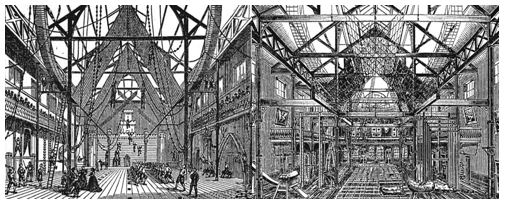
Figures 3 and 4
Inside the Gymnasium
Olympic Festival at Llandudno
The 3rd Olympic Festival took place at the Zoological Gardens Liverpool on 9 July 1864 after being postponed from 2 July due to unfavourable weather conditions. John Hulley, Vice-President of the Athletic Society, was the Director of Festival. The 4th Olympic Festival was held on the 22nd July at the Croquet Grounds, Llandudno instead of in Liverpool. Hulley had a passion about bathing and bathing dress for both males and females and had written at length to The Times and The Liverpool Mercury on the subject in June 1864. He had advocated a new style of dress suitable for both men and women and this had been adopted by the authorities in Llandudno to boost tourism to that seaside resort. The Festival was a great success but a Grand Procession of Illuminated Boats on the Bay, together with a Grand Swimming Race of 100 yards had to be called off due to dispute with the Llandudno boatmen. Seven boats had been engaged by Mr Hulley, coloured lanterns provided for them, and music prepared. It was proposed to have the swimming-match, and that over a procession of boats, with the coloured lights and music on board. The boatmen, however, after having hired themselves to Mr Hulley, again let their boats for a higher sum, so that when that gentleman appeared, he was unable to fulfil his programme, and the swimming had to be adjourned to the following Monday.
In spite of this set-back, the local press were most enthusiastic for a repeat performance. The North Wales Chronicle said that the athletic meeting was still a favourite topic of conversation in Llandudno and its neighbourhood, and was still remembered with pleasure. Associated with this pleasant recollection were the names of Colonel McCorquodale, Mr. Hulley, and Colonel Walmsley. It went on to suggest that could not these gentlemen, assisted by any of the visitors or residents now at Llandudno, organise one more such a gathering. They would be doing a kindness to the town, and would give great gratification to both residents and visitors. The former gathering was a numerous one, but a second one would be far more so. They hoped that Mr Hulley would answer to their appeal.[17]

Figure 5
Grand Procession of illuminated boats at Llandudno
Hulley responded positively and organised a novel Water Fete two weeks later on Saturday evening, 19th August 1865. The whole of the houses facing the sea were lit up, and numbers of boat elegantly decorated, and filled with ladies bearing coloured lampions formed a procession and sailed round the bay. The rocks surrounding the town were brilliantly illuminated, and a carnival was held on the sands by thousands of visitors carrying variegated lanterns of every possible hue. [18] In recognition of Hulley’s to publicise Llandudno, a beautifully illuminated address on vellum, signed by all classes of the inhabitants was forwarded “to the celebrated Gymnasiarch of Liverpool, to whom Llandudno owes so much.”[19]
Opening of the Myrtle Street Gymnasium
Although there was pressure from various quarters to have the gymnasium formally opened, John Hulley delayed this auspicious occasion until a suitable person was available. It had been jokingly reported that the delay was caused by the determination of the directors to wait till the Prince of Wales visits Liverpool, when he can formally open the Gymnasium and that the Queen herself would be coming down to preside at the opening, and inaugurate the proceedings by having a bout at single-stick with the great Gymnasiarch himself. Eventually Lord Derby formally opened it on Tuesday 6 November 1865 and in his speech said that he congratulated the managers upon having in Mr Hulley, a director, who was working, not merely for the salary which he earns, and which they will be the first to admit is a very inadequate recompense for his labour, but who was working out a very real and enthusiastic interest in the business which he was employed to do.[20]
Formation of the National Olympian Association
John Hulley always had a clear view of what constituted an Olympic Education. In 1864 he expressed this in a lecture at the Theatre-Royal Liverpool in which he said “The need for athletic institutes for public gymnastic exercises…for both sexes…in all our towns and cities for ‘the free use of the people,…an agreeable resort for the aged and a pastime for the young.’
On 7 November 1865 The Liverpool Mercury reported the formation of the National Olympian Association (NOA) with its inaugural meeting held at the Liverpool Gymnasium, Myrtle Street with the following persons present:
Mr. John Hulley of Liverpool; Chairman;
Dr. Brookes, Much Wenlock;
Mr. E.G. Ravenstein, president of the German Gymnastic Society, London;
Mr. William Mitchell, Fearness Hall, near Manchester;
Mr. Keeling, Liverpool;
Mr. Murray, London;
Mr. Phillips, Shrewsbury;
and Mr Ambrose Lee, Manchester.
There was also a M. Durbec of Paris listed. [21]
This meeting was the forerunner of the modern British Olympic Association and was formed mainly through the efforts of John Hulley, Dr. Brookes and Mr Ravenstein – the triumvirate of the 19th century Olympic movement.
The link between physical education and the Olympic idea was expressed nicely by John Hulley in 1867. He said ‘What I desire to impress upon you is that Olympic Festivals are not the end of physical education. Physical Education, or rather its dissemination, is the end. Olympian festivals are a means of securing that end.’
The NOA lasted until 1883 and its Olympian Games “were open to all comers”. The NOA and its motto were inherited by the National Physical Recreation Society (NPRS) in 1885/1886 and the NPRS was a founder body of the British Olympic Association in 1905. Indeed the President and the Treasurer of the NPRS were members of Coubertin’s “Comite Brittanique” in 1902. So there is a direct link between Hulley’s views and aspirations in 1864 and the modern British Olympic movement.
Hulley was certainly a tour de force. He began to define Olympism long before the formation of the International Olympic Committee. Like Brookes and Ravenstein he influenced the thinking of the young Coubertin.
Further Olympic Festivals and Displays at Liverpool and Llandudno
Following further Assaults-at Arms at the Gymnasium in December 1865 and March 1866, The Weekly journal “Porcupine” heaped lavish praise on Hulley’s gymnastic and physical education organisational abilities. “To Mr Hulley belongs the honour of establishing the physical culture as a pursuit in the north of England, if not throughout the country, and the success he has achieved has exceeded the utmost anticipations of the few who believed in him, and placed in the most ridiculous light those who ridiculed his endeavours. All that can be done by unfaltering example and by contagious enthusiasm has been done by Mr Hulley, and, beyond this, his direction of the movement has been as wise as it was energetic. He has made himself an authority on his favourite topic; his gymnasium is a model with which athletic students all over the country are eager to compare their institutions; and it only remained for him to develop a system by which it would be possible to constitute the judgements of the gymnasium, as recognized acknowledgements of physical prowess and skill.[22]
Another Athletic Festival was held over a 3 –day period at Llandudno in May, 1866, under John Hulley’s direction but his role of chairman of the National Olympian Association (NOA) seems to have ended by June 1866. It was reported that the NOA had been organised into 3 areas – the Metropolitan and southern counties under Mr. Ravenstein of London, the midland counties under Dr. Brookes of Wenlock, and the northern counties under Mr. Mitchell of Rossendale. John Hulley made an appearance at the First National Olympic Festival held at the River Thames at Teddington for aquatic events and at the Crystal Palace cricket ground for other events. He was dressed in the garb of a Turk was supposed to represent the East – hardly an appropriate display for the first chairman of the NOA, but that was typical of the publicity seeker! [23]
Further gymnastic displays were held at the Gym throughout 1867 and the famous public school at Rugby contacted Hulley for advice on physical education for its pupils. The highlight of the year was the Grand Olympic Festival held at the Gymnasium and the Sheil Park Athletic Grounds in Liverpool on the 28th and 29th of June. There were competitors from Paris, Marseilles, London, a large contingent from Manchester, and most of the Northern counties were represented. It was, in fact, quite a national competition. John Hulley, as President of the Athletic Association, made a speech about the importance of physical education in which he said ” What I desire to impress upon you is that Olympic festivals are not the end of physical education. Physical education, or rather its dissemination, is the end. Olympic festivals are the means of securing that end.”[24]
It appears that John Hulley took a back seat in the organisation of this event because the report of this event which read: “And the programme was got through very shortly after the appointed time, and this act of itself testifies to the completeness of the arrangements. A better managed Olympic festival has not been held in Liverpool; and this is in great measure due to the exertions of Messrs J.B. Lee and W. D. Hogarth, who, after winning many laurels in the ranks as competitors, this year appeared in the character of joint honorary secretaries.”[25]
The financial position of the Liverpool Gymnasium gave cause for concern at the Annual General Meeting held in November 1868. Receipts had dropped by 27% and a loss of £114 had been incurred. John Hulley was not present at the AGM nor at the annual grand athletic fete held in December of that year, but he was back to his normal exuberant self in the early months of 1869 when he was the leading light in bringing the new-fangled invention of the velocipede to Liverpool. The Gymnasium was the centre of this very popular attraction and the Liverpool Velocipede Club was formed there. Events, including a tournament, riding displays and races all helped to publicise the new craze and Hulley was at the centre of most of them. Public races were held at Chester, Rock Ferry and Hoylake where over 1000 spectators witnessed three events.[26]
John Hulley’s marriage
On 16 July 1869 at the Ancient Unitarian Chapel, Toxteth Park John Hulley married Georgiana Bolton, only daughter of Mr. Robert Lewin Bolton, merchant of Liverpool and grand-daughter of the late Mr. Thomas Bolton who was Mayor of Liverpool in 1840. The marriage was an explosive affair with her parents locking her in her room to prevent the ceremony from going ahead. However, love prevailed in the face of adversity and the happy couple tied the knot a day later. This attracted widespread press coverage throughout the country and several reports of the on-off-on marriage filled the columns of the Bradford Observer, Dundee Courier & Argus, Glasgow Herald, Leeds Mercury, Liverpool Courier and Liverpool Mercury for several days after the event.[27]
His later years and early death
John Hulley’s position in the administration of the Liverpool Gymnasium declined in the following months and years. He addressed a crowded gymnasium at the winter re-opening in October 1869, but he was succeeded as manager by Mr. Phillip Shrapnell in September 1870. There were later reports of him visiting North America and roaming through the backwoods, teaching his “noble art” in every village and settlement through which he passed, and driving a whole tribe of Red Indians into the forest by a mere flourish of the huge Indian clubs, which he handled like bulrushes. He was also an avid European traveller and often visited the south of France and Biarritz, especially in the cold English winters.
His death announcement at the early age of 42 came as a shock to many Liverpudlians and the local press paid tribute to him as a well-known and most enthusiastic teacher of gymnastic exercises, and by his advocacy of the importance and value of physical training.[28] A tribute paid to him 13 years after his death said “John Hulley, professor of gymnastics and Gymnasiarch, is still a pleasant memory in this native city. Hulley was born with a mission, which he fulfilled; and, take him for all and all, we may never see his like again”.[29]
His death marked the end of a unique Liverpudlian but the start of a quest by myself to discover more about John Hulley. My first task was to track down the location of Hulley’s grave. I was assisted by the report of his funeral In the local paper dated 12 January 1875. This read inter alia “The funeral of the late Mr. John Hulley, the “gymnasiarch,” took place yesterday morning at the Smithdown-lane cemetery, the body being conveyed in a hearse drawn by four horses, and followed by two mourning coaches and the private carriage of Mr. Aaron Brown.” Liverpool Record Office was very helpful in locating the grave reference and on one of my trips to Lancashire I decided to look for the actual grave in Smithdown Lane (now Road) cemetery. Thanks to a large plan at the entrance it was a simple task to find the grave – number G493.[30] Unfortunately it had been badly damaged in that the headstone had been removed from the main covering stone and the grave was in a very bad condition from 130 years of atmospheric pollution.
The John Hulley Memorial Fund
I contacted Don Anthony, the author of the 2001 article about John Hulley, and Ray Physick of Liverpool, an author of sports books who had expressed an interest in the John Hulley story, and we decided to set up a Memorial Fund through a website to raise money for the restoration of Hulley’s grave; to increase awareness of his part in the founding of the British Olympic movement and to revive the interest in him as one of England’s finest and forward-looking men. This took several months but thanks to generous donations from the International Olympic Committee, the British Olympic Association, and members of the public, sufficient funds were raised to engage a stonemason. We obtained quotations from several Liverpool stonemasons, one of whom gave us a surprise. We were informed that Hulley’s grave consisted of two separate sections – the vertical headstone which had been laid down and the ‘covers’ of the actual grave next to it. Because the latter had no identifying marks on it, I had not realised that it was part of the grave. The stonemason was quite adamant that it could be brought back to its original condition.
Restoration and Rededication of John Hulley’s grave

Figure 6
The Grave after Restoration
He was right! This was taken after the Rededication ceremony in June 2009. Left to right – Don Anthony, Rev. Graham Murphy, Ray Physick and myself. The Olympic flag had been borrowed from the IOC. Let the words of the Revd Graham Murphy B.A. Dip.Post.Theol., Minister of Toxteth Unitarian Chapel Liverpool spoken at the rededication ceremony on Sunday 14 June 2009 under a bright sunny sky, be a fitting conclusion to this story.
“Perceptive men and women of Hulley’s time recognized the boundless vitality, enthusiasm and daring of a true pioneer of sports science. It was easy to ridicule him, and there was no shortage of armchair critics to do just that, not realising how Hulley was simply ever-reinventing himself to ensure his cause was never out of public view. If the advancement of athletics and physical education required him to be a showman, that he would be; he was nothing if not brave and indomitable. Until now, Hulley has suffered from obscurity, following his early death. Let the restoration of his grave be an end to that. It is with great pleasure that I declare this restoration to be the granting to John Hulley of a place in history, which he undoubtedly deserves.”
References
[1] 1841 census The National Archives (TNA) reference HO 107/558/8 folio 21 reverse.
[2] Some Old Liverpudlians [By One Of Them] – No. 11 – John Hulley, Gymnasiarch Liverpool Citizen, February 25 1888, 7.
[3] 1851 census TNA reference HO 107/2193 folio 296 reverse.
[4] 1861 census TNA reference RG 9/2741 folio 45.
[5] Liverpool Mercury, April 25, 1861, 3.
[6] Liverpool Mercury, December 5, 1861, 7.
[7]Ibid June 2, 1862, 1.
[8] Ibid June 16, 1862, 5.
[9] Ibid June 16, 1862, 5.
[10] Ibid June 15, 1863, 3.
[11] Cheshire Observer and Chester, Birkenhead, Crewe and North Wales Times, October 24, 1863, 6.
[12] Liverpool Mercury, January 1, 1864, 1.
[13] Ibid January 4, 1864, 7.
[14] Ibid March 19, 1864, 6.
[15] Ibid July 8, 1864, 6.
[16] Ibid July 19, 1864, 6.
[17] North Wales Chronicle, Llandudno, Wales, August 5, 1865, 3.
[18] Morning Post, August 22, 1865, 3.
[19] Wrexham Advertiser, Denbighshire, Flintshire, Shropshire, Cheshire & North Wales Register, Wrexham, Wales, January 6, 1866, 6.
[20] The Times, November 7, 1865, 5.
[21] Liverpool Mercury, November 7, 1865, 7.
[22] The Porcupine, March 24, 1866, 507.
[23] The Penny Illustrated Paper, August 11, 1866, 84 by Our Gossiper.
[24] Liverpool Mercury, June 29, 1867, 6.
[25] Ibid July 1, 1867, 9.
[26] Ibid May 24, 1869, 5.
[27] Ibid July 17, 1869, 5.
[28] Ibid January 8, 1875, 6.
[29] Some Old Liverpudlians [By One Of Them] – No. 11 – John Hulley, Gymnasiarch Liverpool Citizen, February 25, 1888, 7.
[30] Liverpool Mercury, January 12, 1875, 6.

